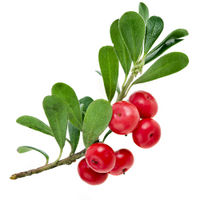Arctostaphylos Uva Ursi
From Health Facts
(Redirected from Bearberry)
Latest Edit: Hector 2014-03-18 (EDT)
| See Also | Botanical Monographs |
|---|
Uva Ursi (Arctostaphylos Uva Ursi) is best known for its use in urinary conditions especially the treatment of urinary infections and an enlarged prostate. To explore the characteristics, medicinal uses and prescribing considerations of this herb in more detail, check out the references indicated.[1], [2]
Contents
Characteristics
- Common Names: Uva Ursi, Bearberry, Kinnikinnick (Klallam Indian), Chipmunk's apples, Mealberry, Tinnick, Sagack-homi (Canadian Indian), Haskin (French), Sac-a-commis (Hudson Bay trader common name), and dozens more. The Latin name means "grapes of the bear," since bears often eat the berries. "Kinnikinnick" in the Klallam language means "smoking mixture."
- Family: Ericaceae
- Habitat: Uva Ursi is found in small thickets in hilly areas in northern areas such as Canada and the upper midwestern United States. It is also found throughout Europe and Asia. It prefers dry and sandy or rocky slopes.
- Parts Used: Leaves collected green in summer and autumn. Ripe fruits have been traditionally cooked into a mock-Cranberry sauce.
- Constituents: phenolic glycosides (arbutin, methylarbutin)
- Medicinal Actions: astringent, smooth muscle tonic, genitourinary antiseptic, nephroprotective, uterine vasoconstrictive, oxytocic, antilithic, diuretic, antimicrobial, decongestant
Uses
- chronic urinary bladder irritation with a lot of pain, tenesmus, catarrh; cystitis; blood, mucous discharge from the genitourinary tract (N. gonorrhea, leucorrhea); weight, dragging, or heaviness in loins/urinary track/perineal area, enlarged prostate; sensation that urinary bladder has lost muscle tone; sensation of a presence in the prostate region, urinary infection in the presence of alkaline urine
- Other Conditions
- H. pylori infection
- The infusion can also be used as a douche for vaginal inflammation and sitz baths after childbirth.
- Uva Ursi is also indicated topically for skin rashes so it can be made into a salve or poultice.[3]
Prescribing Considerations
- The optimal antibacterial actions occur 3-4 hours after ingesting Uva Ursi.[4]
- Enteric coated capsules displayed the same bioavailability as the tincture.[5]
- The tannins are responsible for the soothing, toning, and strengthening the membranes of the urinary tract. [4] Avoid any substance which causes acidic urine as this decreases its antibacterial effects.
The information provided is intended to augment the treatment from a naturopathic doctor or other trained medical professional. Although most herbs are generally safe, it is recommended that you avoid self-prescribing especially when there is an underlying ongoing medical condition, if you are on any prescription medications or if you are pregnant or breastfeeding.
Formulations and Preparation
- Powder - 15-60 grain
- Decoction - 30g leaf in 750mL of water, boil and simmer for 30 min to 500mL
- Infusion - 1-4g of leaf added to 90mL of water as a tea
- Tincture - 30-60 drops (50% alcohol) three times daily
- Fluid extract - 10-30 drops three times daily
Satefy
The safety and prescribing considerations for this herb include:[6], [7]
- Generally regarded as safe, yet don't use consecutively for more than 14 days as excess of hydroxyquinone can cause vertigo, nausea, vomiting and convulsions.
- Side Effects: Doses as high as 20 grams have produced no adverse effects in healthy individuals. Urine may turn green but is harmless.
- Cautions: If used with other diuretics, there may be a significant loss of electrolytes. Tannins will also inhibit optimal nutrient uptake in the intestines so avoid long term use.
- Contraindications: Children, pregnant or lactating women, kidney disease.
- Drug-Herb Interactions are not known.
References
- ↑ Boon Heather, Smith Michael (2009) 55 Most Common Medicinal Herbs: The Complete Natural Medicine Guide Institute of Naturopathic Education and Research, CCNM Toronto.
- ↑ Godfrey Anthony, Saunders Paul, Barlow Kerry, Gowan Matt (2011) Principles and Practices of Naturopathic Botanical Medicine, Advanced Botanical Medicine. V3 CCNM Press, Toronto.
- ↑ Schofield Janice (1995) Discovering Wild Plants. Alaska Northwest Books, Seattle, WA.
- ↑ 4.0 4.1 Stelling Keith (Nov 1999) Uva Ursi (Bearberry). Canadian Journal of Health and Nutrition.;205.
- ↑ Mills Simon, Bone Kerry (2000) Principles and Practice of Phytotherapy. Churchill Livingstone: New York.
- ↑ Stargrove Mitchell Bebell, Treasure Jonathan, McKee Dwight L (2008) Herb, Nutrient and Drug Interactions: Clinical Implications and Therapeutic Strategies
- ↑ Brinker Francis (1997) Herbal Contraindications and Drug Interactions: Plus Herbal Adjuncts With Medicines, 4th Edition Eclectic Medical Publications.
